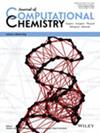呼吸金属有机框架的顺磁性:钴、镍和铜桨轮二次建筑单元的理论模型。
IF 4.8
3区 化学
Q2 CHEMISTRY, MULTIDISCIPLINARY
引用次数: 0
摘要
在二级结构单元(SBUs)中含有顺磁性金属阳离子的金属有机骨架(mof)在单分子磁体、分子自旋电子学和量子计算等磁性材料中具有潜在的应用前景。以M2(O2CH)4和M2(O2CH)4(C6H12N2)2系统为模型,对嵌入呼吸顺磁mof的桨轮SBUs进行了量子化学研究,特别是M2(bdc)2(dabco) (dabco = C6H12N2, bdc2- = C8H4O4 2-, M2+ = Co2+, Ni2+, Cu2+)。对这些模型的电子态和原子间相互作用进行了分析,并与M2(bdc)2(dabco)的热容和磁化率实验数据进行了比较。结果表明,金属原子自旋的反平行有序(对称性破缺)是模型系统的最低自旋态。dabco分子的配位使得高自旋态成为第二稳定的自旋态,与对称性破缺溶液的能量分离相对较小。本文章由计算机程序翻译,如有差异,请以英文原文为准。
The Paramagnetic Properties of Breathing Metal-Organic Frameworks: Theoretical Models for Paddle-Wheel Secondary Building Units of Cobalt, Nickel, and Copper.
The metal-organic frameworks (MOFs) that contain paramagnetic metal cations at their secondary building units (SBUs) have potential applications in magnetic materials for single molecule magnets, molecular spintronics, and quantum computing. The quantum chemical investigations were carried out on the systems M2(O2CH)4 and M2(O2CH)4(C6H12N2)2, which model paddle-wheel SBUs embedded in breathing paramagnetic MOFs, specifically M2(bdc)2(dabco) (dabco = C6H12N2, bdc2- = C8H4O4 2-, M2+ = Co2+, Ni2+, Cu2+). An analysis of the electronic states and interatomic interactions for these models was performed and compared with experimental data on heat capacity and magnetic susceptibility of M2(bdc)2(dabco). It is shown that the antiparallel ordering (broken symmetry) of the spins on the metal atoms is the lowest spin state of the model systems. The coordination of the dabco molecules makes the high-spin state the second most stable spin state, with a relatively small energy separation from the broken symmetry solution.
求助全文
通过发布文献求助,成功后即可免费获取论文全文。
去求助
来源期刊
CiteScore
6.60
自引率
3.30%
发文量
247
审稿时长
1.7 months
期刊介绍:
This distinguished journal publishes articles concerned with all aspects of computational chemistry: analytical, biological, inorganic, organic, physical, and materials. The Journal of Computational Chemistry presents original research, contemporary developments in theory and methodology, and state-of-the-art applications. Computational areas that are featured in the journal include ab initio and semiempirical quantum mechanics, density functional theory, molecular mechanics, molecular dynamics, statistical mechanics, cheminformatics, biomolecular structure prediction, molecular design, and bioinformatics.

 求助内容:
求助内容: 应助结果提醒方式:
应助结果提醒方式:


